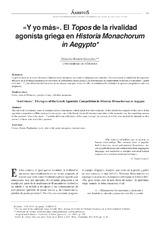Mostrar el registro sencillo del ítem
«Y yo más». El Topos de la rivalidad agonísta griega en Historia Monachorum in Aegypto
| dc.contributor.author | Romero González, Dámaris | |
| dc.date.accessioned | 2016-10-04T07:36:22Z | |
| dc.date.available | 2016-10-04T07:36:22Z | |
| dc.date.issued | 2015 | |
| dc.identifier.issn | 1575-2100 | |
| dc.identifier.issn | 2386-4494 | |
| dc.identifier.uri | http://hdl.handle.net/10396/13867 | |
| dc.description.abstract | La pervivencia de un topos literario es habitual entre literaturas, las cuales lo adaptan a sus contextos. En esta ocasión se analizarán dos aspectos del topos de la rivalidad agonística en dos textos de la literatura clásica griega y de la monástica: la sorprendente respuesta a la pregunta ‘¿quién es el más…?’ y las diferentes definiciones de un mismo concepto. A raíz de ello, se estudiarán las actitudes de quienes preguntaron ante esa respuesta. | es_ES |
| dc.description.abstract | The survival of a literary topos is common across Literatures, which adapt it to their contexts. In this article two aspects of the topos of the agonistic competition will be analysed in two texts, one of the Greek classical Literature and other of the monastic one: the surprising answer to the question ‘who is the most…?’ and the different definitions of the same concept. As a result, it will be also studied the attitudes to this answer of those who asked this question. | es_ES |
| dc.format.mimetype | application/pdf | es_ES |
| dc.language.iso | spa | es_ES |
| dc.publisher | Asociación de Estudios de Ciencias Sociales y Humanidades | es_ES |
| dc.rights | https://creativecommons.org/licenses/by-nc-nd/4.0/ | es_ES |
| dc.source | Ámbitos (34), 41-46 (2015) | es_ES |
| dc.subject | Creso | es_ES |
| dc.subject | Ciclo de Pafnucio | es_ES |
| dc.subject | Quién es el más | es_ES |
| dc.subject | Soberbia | es_ES |
| dc.subject | Monacato | es_ES |
| dc.subject | Cresus | es_ES |
| dc.subject | Solon | es_ES |
| dc.subject | Paphnutius cycle | es_ES |
| dc.subject | Who is the most | es_ES |
| dc.subject | Arrogance | es_ES |
| dc.subject | Monasticism | es_ES |
| dc.title | «Y yo más». El Topos de la rivalidad agonísta griega en Historia Monachorum in Aegypto | es_ES |
| dc.type | info:eu-repo/semantics/article | es_ES |
| dc.rights.accessRights | info:eu-repo/semantics/openAccess | es_ES |

